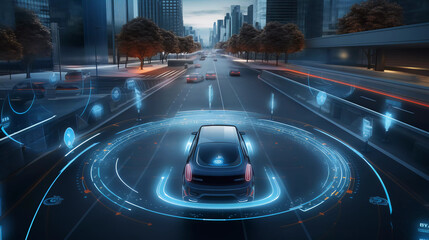Sensors Used in ADAS Systems: A Comprehensive Guide
Read Time 8 mins | Written by: Anuj Kharnal

As Advanced Driver Assistance Systems (ADAS) become increasingly integral to modern vehicles, the role of sensors in enabling these systems has never been more critical. From facilitating lane-keeping assistance to enabling automatic emergency braking, sensors are the eyes and ears of ADAS. This blog aims to delve into the types of sensors commonly used in ADAS and how they contribute to safer and more efficient driving experiences.
Radar Sensors
Overview
Radar, or Radio Detection and Ranging, is one of the oldest and most reliable sensor technologies used in ADAS. By sending out radio waves and measuring the time it takes for them to return after hitting an object, radar sensors can determine the distance, speed, and direction of objects around the vehicle.
Applications
- Adaptive Cruise Control: Maintains a safe following distance from the vehicle ahead.
- Blind Spot Detection: Alerts the driver to vehicles in the blind spots.
Lidar Sensors
Overview
Light Detection and Ranging (Lidar) uses laser beams to measure distances to objects. Unlike radar, which uses radio waves, Lidar provides much higher resolution and can create detailed 3D maps of the vehicle's surroundings.
Applications
- Lane Departure Warning: Detects lane markings and alerts the driver if the vehicle starts to drift.
- Pedestrian Detection: Recognizes pedestrians in the vehicle's path and can trigger automatic emergency braking.
Cameras
Overview
Cameras are optical sensors that capture visual data, which is then processed to identify various elements like road signs, lane markings, and obstacles. While they lack the range of radar and Lidar, cameras offer the advantage of color recognition, which can be crucial for tasks like traffic light detection.
Applications
- Traffic Sign Recognition: Identifies road signs and displays them on the dashboard.
- Lane Keeping Assistance: Detects lane markings and helps the vehicle stay within them.
Ultrasonic Sensors
Overview
Ultrasonic sensors use sound waves to detect objects. They are particularly useful for short-range applications and are most commonly found in parking assistance systems.
Applications
- Parking Assistance: Guides the vehicle into a parking spot.
- Obstacle Detection: Alerts the driver to obstacles in close proximity, like curbs or shopping carts.
Infrared Sensors
Overview
Infrared sensors detect heat signatures and are particularly useful for nighttime and low-visibility conditions. They can identify warm objects, like animals or people, even in complete darkness.
Applications
- Night Vision: Displays a thermal image of the road ahead.
- Animal Detection: Alerts the driver to animals crossing the road.
Sensor Fusion: The Synergy of Technologies
What is Sensor Fusion?
Sensor fusion refers to the process of integrating data from multiple sensors to create a more comprehensive and accurate understanding of the vehicle's surroundings. By combining the strengths of each sensor type and compensating for their weaknesses, sensor fusion aims to significantly enhance the reliability and performance of ADAS features.
Why is it Important?
Complementary Strengths
Each type of sensor comes with its own set of advantages and limitations. For instance, while radar excels in detecting objects at a distance, it struggles with high-resolution mapping. Conversely, Lidar provides detailed spatial data but is less effective in adverse weather conditions. Sensor fusion combines these complementary strengths to offer a more robust system.
Improved Reliability
Sensor fusion improves the overall reliability of ADAS by enabling cross-verification among different sensor types. If one sensor fails or gives inaccurate readings, the fused data from other sensors can help correct or validate the information, thereby reducing the risk of false positives or negatives.
Advanced Features
The amalgamation of data from multiple sensors opens the door for more advanced and reliable ADAS features. For example, a fusion of camera and radar data can improve the accuracy of pedestrian detection systems, especially in low-light conditions.
Real-World Applications
Adaptive Cruise Control with Lane Centering
Many modern vehicles combine radar and camera data to offer advanced adaptive cruise control systems that not only maintain a safe following distance but also keep the vehicle centered in its lane.
360-Degree Surround View
A combination of ultrasonic sensors and cameras can provide a comprehensive 360-degree view around the vehicle, significantly aiding in parking and low-speed maneuvering.
Emergency Response Systems
Sensor fusion can be critical in emergency response systems. For instance, integrating data from Lidar, radar, and cameras can enable highly reliable automatic emergency braking systems that can differentiate between a pedestrian, a cyclist, and a stationary object.
Sensor Applications Across Different Levels of Automated Driving
| Level 0 | Level 1 | Level 2 | Level 3 | Level 4 | Level 5 | |
|---|---|---|---|---|---|---|
| Radar | - |
Adaptive Cruise Control
|
Adaptive Cruise Control Blind Spot Detection |
Advanced Adaptive Cruise Control Blind Spot Detection |
High-level Adaptive Cruise Control High-level Blind Spot Detection |
Fully Autonomous Adaptive Cruise Control Fully Autonomous Blind Spot Detection |
| Lidar | - | - |
Lane Departure Warning Pedestrian Detection |
Advanced Lane Departure Warning Advanced Pedestrian Detection |
High-level Lane Departure Warning High-level Pedestrian Detection |
Fully Autonomous Lane Departure Warning Fully Autonomous Pedestrian Detection |
| Camera | - |
Lane Keeping Assistance
|
Traffic Sign Recognition Lane Keeping Assistance |
Advanced Traffic Sign Recognition Advanced Lane Keeping Assistance |
High-level Traffic Sign Recognition High-level Lane Keeping Assistance |
Fully Autonomous Traffic Sign Recognition Fully Autonomous Lane Keeping Assistance |
| Ultrasonic | - |
Parking Assistance
|
Parking Assistance Obstacle Detection |
Advanced Parking Assistance Advanced Obstacle Detection |
Fully Autonomous Parking
|
Fully Autonomous Parking Fully Autonomous Obstacle Detection |
| Infrared | - | - |
Night Vision
|
Advanced Night Vision Animal Detection |
High-level Night Vision High-level Animal Detection |
Fully Autonomous Night Vision Fully Autonomous Animal Detection |
Conclusion
As ADAS technologies evolve, we can expect sensor fusion to become increasingly sophisticated, incorporating newer types of sensors and machine learning algorithms for more intelligent data integration. This will pave the way for more advanced safety features and, eventually, fully autonomous driving capabilities.
Sensors are the backbone of Advanced Driver Assistance Systems, providing the crucial data that enable these systems to function effectively. Understanding the different types of sensors and their applications can help automotive companies make informed decisions when developing or enhancing ADAS technologies. As sensor technologies continue to evolve, we can expect even more advanced and reliable ADAS features that will contribute to safer and more efficient driving experiences for all.

